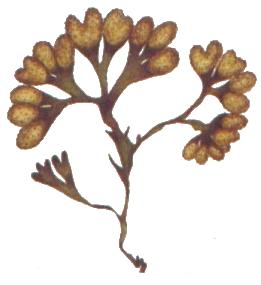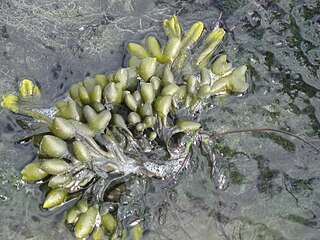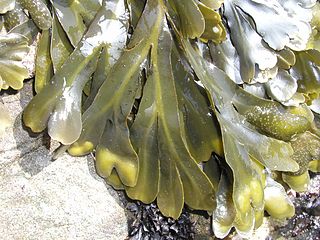This page is based on this
Wikipedia article Text is available under the
CC BY-SA 4.0 license; additional terms may apply.
Images, videos and audio are available under their respective licenses.

Seaweed fertiliser, also spelled seaweed fertilizer, is seaweed that is collected and used as an organic fertilizer.

Strangford Lough is a large sea loch or inlet in County Down, in the east of Northern Ireland. It is the largest inlet in the British Isles, covering 150 km2 (58 sq mi). The lough is almost totally enclosed by the Ards Peninsula and is linked to the Irish Sea by a long narrow channel at its southeastern edge. The main body of the lough has at least seventy islands along with many islets (pladdies), bays, coves, headlands and mudflats. Strangford Lough was designated as Northern Ireland's first Marine Conservation Zone (MCZ) under the introduction of the Marine Act 2013. It has also been designated a Special Area of Conservation under the EU Habitats Directive, and its abundant wildlife is recognised internationally for its importance.

Fucitol, also known as L-fucitol, 6-deoxy-L-galactitol, and (2R,3S,4R,5S)-hexane-1,2,3,4,5-pentol, is a sugar alcohol derived from fucoidin which is found in the North Atlantic seaweed Fucus vesiculosus or by the reduction of fucose.

Fucus serratus is a seaweed of the north Atlantic Ocean, known as toothed wrack or serrated wrack.

Spirorbis spirorbis is a small (3–4 mm) coiled polychaete that lives attached to seaweeds and eel grass in shallow saltwater.

Fucus spiralis is a species of seaweed, a brown alga, living on the littoral shore of the Atlantic coasts of Europe and North America. It has the common names of spiral wrack and flat wrack.

Wrack is part of the common names of several species of seaweed in the family Fucaceae. It may also refer more generally to any seaweeds or seagrasses that wash up on beaches and may accumulate in the wrack zone.
Elsie May Burrows (1913–1986) was an English botanist who made significant contributions to British postwar phycology. Her primary area of research was macroalgal ecology, focusing particularly on Fucus, a genus of brown algae, and Chlorophyta, a division of the green algae.
A tangie is a shape-shifting sea spirit in the folklore of the Orkney and Shetland Islands in the British Isles. A sea horse or merman, it takes on the appearance of either a horse or an aged man. Usually described as being covered with seaweed, its name derives from "tang" or seaweed of the genus Fucus.

Seaweed or macroalgae refers to several species of macroscopic, multicellular, marine algae. The term includes some types of red, brown, and green macroalgae. Marine algae species such as kelps provide essential nursery habitat for fisheries and other marine species and thus protect food sources; ocean algae species from seaweeds to planktons play a vital role in carbon capture, producing up to 90 percent of the planet's oxygen. Understanding these roles provides guiding principles for conservation and sustainable use of seaweeds to take precedence over industrial exploitation. Mechanical dredging of kelp, for instance, destroys the resource and dependent fisheries. Certain species of seaweed are valuable for nutrition, biomedicine, bioremediation, and other uses.

The sea stickleback, also known as the fifteen-spined or fifteenspine stickleback, is a species of stickleback which lives in benthopelagic and in brackish environments of the northeastern Atlantic Ocean. This species, the largest of the sticklebacks, grows to a length of 22 centimetres (8.7 in) SL. This species is the only known member of its genus Spinachia. It is of no interest as a commercial fish.

Fucus radicans is a species of brown algae in the family Fucaceae, endemic to and recently evolved within the Baltic Sea. The species was first described by Lena Bergström and Lena Kautsky in 2005 from a location in Ångermanland, Sweden. The specific epithet is from the Latin and means "rooting", referring to the fact that this species primarily reproduces by the taking root of detached fragments.
Fucus virsoides is a species of brown alga endemic to the Adriatic Sea. The Bay of Kotor was defined as one of the southernmost limits of Fucus virsoides.

Fucus guiryi G. I. Zardi, K. R. Nicastro, E. S. Serrão, G. A. Pearson is a brown alga in the family Fucaceae. It is known from numerous locations along the east coast of the North Atlantic Ocean, from Ireland to the Canary Islands.

Furcellaria is a genus of red algae which has commercial importance as a raw material for carrageenan production. It is mainly harvested from the waters of Denmark and Canada.

Fucus ceranoides is a species of brown algae found in the littoral zone of the sea shore.
Cryptostomata are anatomical structures found in some species of Fucus and not in Pelvetia canaliculata. They are conceptacles, sterile cavities, producing only hairs.They are found on the lamina of Fucus serratus. Colourless tufts of hairs can be seen issuing from them.














